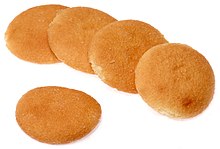Nilla
 | |
 | |
| Product type | Cookie |
|---|---|
| Owner | Mondelez International |
| Country | U.S. |
| Introduced | 1898 |
| Previous owners | Nabisco |
| Website | snackworks.com/nilla |


Nilla is a brand name owned by Nabisco, a subsidiary of Illinois-based Mondelēz International, widely associated with its line of vanilla-flavored, wafer-style cookies.
The name is a shortened version of vanilla, the flavor profile common to all Nilla-branded products. Originally marketed as Nabisco Vanilla Wafers, the product's name was changed in 1967 to the abbreviated form, Nilla Wafer.[1] Originally a round, thin, light wafer cookie made with flour, sugar, shortening, eggs[2] and real vanilla, Nilla wafers have been primarily flavored with synthetic vanillin since at least 1994, a change which prompted criticism.[3][4] Nilla wafers are described as having "natural and artificial flavor", according to the ingredients list on the box.[5]
Nilla also produces a variety of spin-off products, including pie crusts. The crusts were introduced in 1992 alongside pie crusts flavored like two other Nabisco cookie brands, Oreos and Honey Grahams.[6]
History[edit]
The recipe for vanilla wafers or sugar wafers was invented in the late 19th century by German-American confectioner Gustav A. Mayer on Staten Island.[7][8][9] He sold his recipe to Nabisco, and Nabisco began to produce the biscuits under the name Vanilla Wafers in 1898.[1] By the 1940s, Vanilla Wafers had become a major ingredient in the Southern cuisine staple banana pudding, and Nabisco began printing a banana pudding recipe on the Vanilla Wafers box.[10][11] The name of the product was not changed to "Nilla Wafers" until 1967.[1][12]
In 2013, the brand launched an advertising campaign on Facebook and other social media websites targeted at mothers, a campaign noted by the New York Times as unique because Mondelez International, the company that Kraft created to own the brand, spent its advertising dollars on social media rather than a combination of advertising platforms. The campaign resulted in a 9% increase in sales for Nilla.[13] Nabisco had previously used other marketing techniques to promote the brand, including in-person events such as sponsoring banana pudding pie eating contests at amusement parks.[14]
Uses[edit]
Nilla wafers are a common ingredient in banana pudding and are consequently popular in the American South. In Atlanta and Houston, they are consistently in the five best-selling cookie brands.[15]
The wafers themselves are commonly used to facilitate the oral administration of various compounds or medications to rats in testing.[16] Nilla's branding has been used to study consumer preferences about variations in packaging.[17]
References[edit]
- ^ a b c "Counterintuitive Wafers - December 6, 1999". archive.fortune.com. Retrieved 2017-10-08.
- ^ Hartel, Richard W. (2006-06-06). "Cracker or cookie: What's the diff?". The Capital Times. Archived from the original on 2017-10-08.
- ^ Hofsess, Diane (1994-02-24). "Shopping? It's Smart To Be Suspicious". Chicago Sun-Times. Archived from the original on 2017-10-07.
- ^ Hermann, Andrew (1997-09-16). "New, improved – or just different". Chicago Sun-Times. Archived from the original on 2017-10-07.
Nilla wafers no longer have any vanilla in them.
- ^ Bomgardner, Melody M. (2016-09-12). "The problem with vanilla". Chemical & Engineering News. 94 (36).
- ^ "'Sinkies' Get Serious". Post-Tribune (IN). 1992-11-25. Archived from the original on 2017-10-08.
- ^ Gould, Jennifer; Rosenbaum, Sophia (2015-02-26). "'Haunted' Staten Island mansion can be yours for $2 million". New York Post. Retrieved 2017-10-08.
- ^ Kroessler, Jeffrey A. (August 2002). New York Year by Year: A Chronology of the Great Metropolis. NYU Press. p. 115. ISBN 9780814747506.
Gustav a. Mayer.
- ^ "Meet Gustav A. Mayer". Zinn Brilliant. Retrieved 4 November 2019.
Mayer moved to the U.S. in the late 1850s at age 19. In the 1880s Mayer's mold-making experience led him to design a line of indirectly-lit, tin Christmas ornaments. - ^ "Why do Southerners go bananas for banana pudding? | Southern Perspective". Pensacola News Journal. Retrieved 2019-05-03.
- ^ Eats, Serious. "How Banana Pudding Became a Southern Icon". www.seriouseats.com. Retrieved 2017-10-08.
- ^ Office, Library of Congress Copyright (1967). Commercial Prints and Labels. U.S. Government Printing Office.
Nilla vanilla wafers are the same sweet Nabisco vanilla wafers with a brand new name.
- ^ Segal, David (2 November 2013). "Riding the Hashtag in Social Media Marketing". New York Times. Retrieved 6 October 2017.
- ^ Terry Halbert; Elaine Ingulli (1 February 2014). Law and Ethics in the Business Environment. Cengage Learning. p. 275. ISBN 978-1-305-17787-1.
- ^ "Consumer snack preferences; Oreos still no. 1 cookie. (New Product Activity Outpacing 2004) (Brief Article)". The Food Institute Report. 2005-11-14. Archived from the original on 2017-10-08.
- ^ Sobolewski, Marissa; Allen, Joshua L.; Morris-Schaffer, Keith; Klocke, Carolyn; Conrad, Katherine; Cory-Slechta, Deborah A. (2016-07-01). "A novel, ecologically relevant, highly preferred, and non-invasive means of oral substance administration for rodents". Neurotoxicology and Teratology. 56 (Supplement C): 75–80. doi:10.1016/j.ntt.2016.04.002. PMC 5663185. PMID 27094606.
For example, it is common to use a wafer cookie for oral administration to mice and rats
- ^ Roehm, Michelle L.; Roehm, Harper A. (2010-12-01). "The relationship between packaging uniformity and variety seeking". Psychology & Marketing. 27 (12): 1122–1133. doi:10.1002/mar.20376. ISSN 1520-6793.
